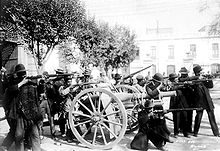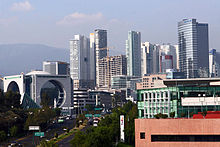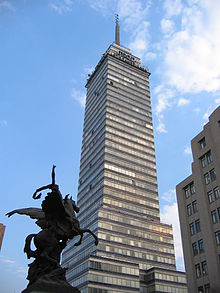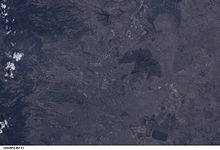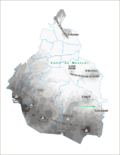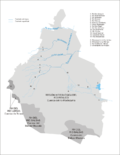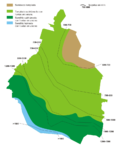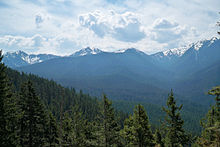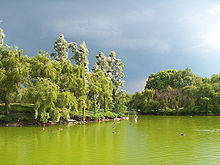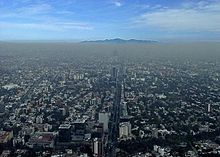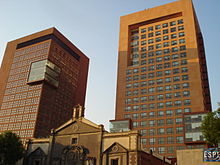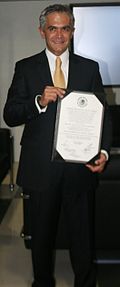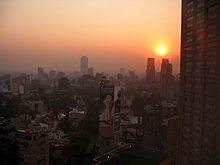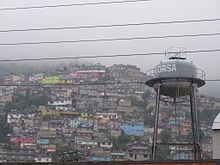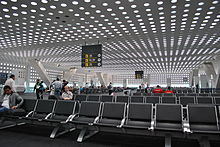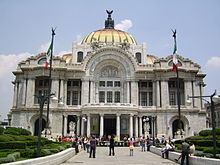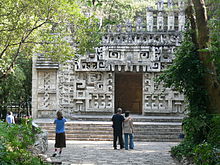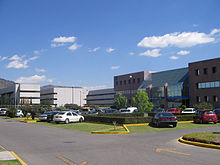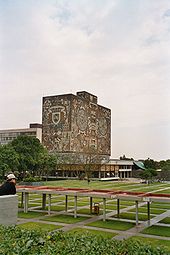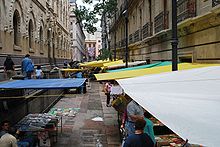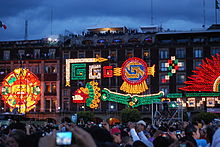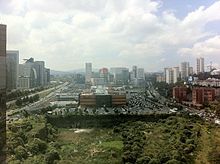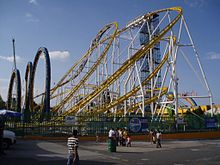
Mexico City
Background to the schools Wikipedia
This wikipedia selection has been chosen by volunteers helping SOS Children from Wikipedia for this Wikipedia Selection for schools. Click here for more information on SOS Children.
| Mexico City | |||||
|---|---|---|---|---|---|
| — City — | |||||
| Ciudad de México City of Mexico |
|||||
|
|||||
| Nickname(s): La Ciudad de los Palacios (The City of Palaces) |
|||||
| México City within Mexico | |||||
| Coordinates: 19°26′N 99°8′W | |||||
| Country | |||||
| Entity | Federal District | ||||
| Subdivisions |
Boroughs
|
||||
| Founded |
|
||||
| Government | |||||
| • Head of Government | Miguel Ángel Mancera |
||||
| • Senators | Pablo Gómez René Arce Federico Döring |
||||
| • Deputies |
Federal Deputies
|
||||
| Area | |||||
| • Total | 1,485 km2 (573 sq mi) | ||||
| Ranked 32nd | |||||
| Elevation | 2,241 m (7,352 ft) | ||||
| Highest elevation | 3,930 m (12,890 ft) | ||||
| Population (2010) | |||||
| • Total | 8,851,080 | ||||
| • Rank | 2nd | ||||
| • Density | 6,000/km2 (15,000/sq mi) | ||||
| • Density rank | 1st | ||||
| Demonym | Capitalino (a) Defeño (a) Mexiqueño (a) Chilango (a) |
||||
| Time zone | CST ( UTC−6) | ||||
| • Summer ( DST) | CDT ( UTC−5) | ||||
| Postal code | 00–16 | ||||
| Area code |
Area codes
|
||||
| ISO 3166 code | MX-DFE | ||||
| HDI | |||||
| GDP | 1.153 trillion | ||||
| Website | Official Web Site | ||||
| ^ b. Area of the Federal District that includes non-urban areas at the south | |||||
Mexico City (pron.: / ˈ m ɛ k s ɨ k oʊ ˈ s ɪ t i /; Spanish: Ciudad de México [sjuˈðað ðe ˈmexiko], also known as México, D. F., or simply D.F.) is the Federal District (Distrito Federal), capital of Mexico and seat of the federal powers of the Mexican Union. It is a federal entity within Mexico which is not part of any one of the 31 Mexican states but belongs to the federation as a whole. Mexico City is the country's largest city as well as its most important political, cultural, educational and financial centre.
As an "alpha" global city, Mexico City is one of the most important financial centers in North America. It is located in the Valley of Mexico (Valle de México), a large valley in the high plateaus at the centre of Mexico, at an altitude of 2,240 metres (7,350 ft). The city consists of sixteen boroughs.
The 2009 estimated population for the city proper was around 8.84 million people, and has a land area of 1,485 square kilometres (573 sq mi). According to the most recent definition agreed upon by the federal and state governments, the Mexico City metropolitan area population is 21.2 million people, making it the largest metropolitan area in the western hemisphere, the fifth largest agglomeration and the largest Spanish-speaking city in the world.
The Greater Mexico City has a gross domestic product (GDP) of US$390 billion in 2008, making Mexico City urban agglomeration the eighth richest metropolitan area in the world. The city was responsible for generating 21% of Mexico's Gross Domestic Product and the metropolitan area accounted for 34% of total national GDP.
The city was originally built on an island of Lake Texcoco by the Aztecs in 1325 as Tenochtitlan, which was almost completely destroyed in the 1521 siege of Tenochtitlan, and subsequently redesigned and rebuilt in accordance with the Spanish urban standards. In 1524, the municipality of Mexico City was established, known as México Tenochtitlán, and as of 1585 it was officially known as Ciudad de México (Mexico City). Mexico City served as the political, administrative and financial centre of a major part of the Spanish colonial empire. After independence from Spain was achieved, the Federal District was created in 1824.
After years of demanding greater political autonomy, residents were given the right to directly elect the Head of Government and the representatives of the unicameral Legislative Assembly by popular vote in 1997. Ever since, the left-wing Party of the Democratic Revolution (PRD) has controlled both of them. In recent years, the local government has passed a wave of liberal policies, such as abortion on request, a limited form of euthanasia, no-fault divorce and same-sex marriage.
History of Mexico City
Aztec period
The city currently known as Mexico City was founded by the Mexica people, later known as the Aztecs, in 1325. The old Mexica city is now referred to as Tenochtitlan. The Mexica were one of the last of the Nahuatl-speaking peoples who migrated to this part of the Valley of Mexico after the fall of the Toltec Empire. Their presence was resisted by the peoples who were already in the valley, but the Mexica were able to establish a city on a small island on the western side of Lake Texcoco. The Mexica themselves had a story about how their city was founded, after being led to the island by their principal god, Huitzilopochtli. According to the story, the god indicated the site where they were to build their home with a sign - an eagle perched on a nopal cactus with a snake in its beak. Between 1325 and 1521, Tenochtitlan grew in size and strength, eventually dominating the other city-states around Lake Texcoco, and in the Valley of Mexico. When the Spaniards arrived, the Aztec Empire reached much of Mesoamerica, touching both the Gulf of Mexico and the Pacific Ocean. Scholars estimate that between 200,000 and 250,000 people lived in Tenochtitlan in 1500, more than four times the population of London. It was easily one of the largest cities of it's time and the largest in the Americas before the Spanish conquest.
Spanish conquest of Tenochtitlán
After landing in Veracruz, Hernán Cortés heard about the great city and the long-standing rivalries and grievances against it. Although Cortés came to Mexico with a very small army, he was able to persuade many of the other native peoples to help him destroy Tenochtitlan. Cortés first saw Tenochtitlán on November 8, 1519. Upon viewing it for the first time, Cortés and his men were stunned by its beauty and size. The Spaniards marched along the causeway leading into the city from Iztapalapa. Although Montezuma came out from the centre of Tenochtitlán to greet them and exchange gifts, the camaraderie did not last long. Cortés put Montezuma under house arrest, hoping to rule through him. Tensions increased until, on the night of June 30, 1520 – during a struggle commonly known as " La Noche Triste" – the Aztec revolted against the Spanish intrusion and managed to capture or drive out the Europeans and their Tlaxcalan allies. Cortés regrouped at Tlaxcala. The Aztecs thought the Spaniards were permanently gone. They elected a new king, Cuitláhuac, but he died after a few months due to smallpox; the next king was Cuauhtémoc. Cortés decided to lay siege to Tenochtitlán in May 1521. For three months, the city suffered from the lack of food and water as well as the spread of smallpox brought by the Europeans. Cortés and his allies landed their forces in the south of the island and fought their way through the city, street by street, and house by house. Finally, Cuauhtémoc had to surrender in August 1521.
The rebuilding of the city as Mexico City
The Spaniards practically razed Tenochtitlán. Cortés first settled in Coyoacán, but decided to rebuild the Aztec site to erase all traces of the old order. Cortés did not establish an independent, conquered territory under his own personal rule, but remained loyal to the Spanish crown. The first viceroy of the new domain arrived in Mexico City fourteen years later. By that time, the city had again become a city-state, having power that extended far beyond the city's established borders. Although the Spanish preserved Tenochtitlán's basic layout, they built Catholic churches over the old Aztec temples and claimed the imperial palaces for themselves. Tenochtitlán was renamed "Mexico", its alternative form name, only because the Spanish found this easier to say.
Growth of the colonial city
The city grew as the population did, coming up against the lake's waters. The 16th century saw a proliferation of churches, many of which can still be seen today in the historic centre. Economically, Mexico City prospered as a result of trade. Unlike Brazil or Peru, Mexico had easy contact with both the Atlantic and Pacific worlds. Although the Spanish crown tried to completely regulate all commerce in the city, it had only partial success.
The concept of nobility flourished in New Spain in a way not seen in other parts of the Americas. Spaniards encountered a society in which the concept of nobility mirrored that of their own. Spaniards respected the indigenous order of nobility and added to it. In the ensuing centuries, a noble title in Mexico did not mean one exercised great political power as one's power was limited even if the accumulation of wealth was not. The concept of nobility in Mexico was not political but rather a very conservative Spanish social one, based on proving the worthiness of the family. Most of these families proved their worth by making fortunes in New Spain outside of the city itself, then spending the revenues in the capital, building churches, supporting charities and building extravagant palatial homes. The craze to build the most opulent home possible reached its height in the last half of the 18th century. Many of these homes can still be seen today, leading to Mexico City's nickname of "The city of palaces" given by Alexander Von Humboldt.
The Grito de Dolores ("Cry of Dolores") also known as El Grito de la Independencia ("Cry of Independence"), uttered from the small town of Dolores near Guanajuato on September 16, 1810, is the event that marks the beginning of the Mexican War of Independence and is the most important national holiday observed in Mexico. The "Grito" was the battle cry of the Mexican War of Independence by Miguel Hidalgo y Costilla, a Roman Catholic priest. Hidalgo and several criollos were involved in a planned revolt against the Spanish colonial government, and the plotters were betrayed. Fearing his arrest,[1] Hidalgo commanded his brother Mauricio as well as Ignacio Allende and Mariano Abasolo to go with a number of other armed men to make the sheriff release the pro-independence inmates there on the night of September 15. They managed to set eighty free. Around 6:00 am September 16, 1810, Hidalgo ordered the church bells to be rung and gathered his congregation. Flanked by Allende and Juan Aldama, he addressed the people in front of his church, encouraging them to revolt. The Battle of Guanajuato, the first major engagement of the insurgency, occurred four days later. Mexico's independence from Spain was effectively declared in the Declaration of Independence of the Mexican Empire on September 27, 1821, after a decade of war. Unrest followed for the next several decades, as different factions fought for control of Mexico.
The Mexican Federal District was established by the new government and by the signing of their new constitution, where the concept of a federal district was adapted from The U.S. constitution. Before this designation, Mexico City had served as the seat of government for both the State of Mexico and the nation as a whole. Texcoco and then Toluca became the capital of the state of Mexico.
The Battle of Mexico City
The Mexican–American War came to a close after the United States deployed combat units deep into Mexico resulting in the capture of Mexico City and Veracruz by the U.S. Army's 1st, 2nd, 3rd and 4th Divisions. The invasion culminated with the storming of Chapultepec Castle in the city itself. The treaty of Guadalupe Hidalgo was signed in what is now the far north of the city. Events such as the Reform War left the city relatively untouched and it continued to grow, especially during the rule of President Porfirio Díaz. During this time, the city developed a modern infrastructure, such as roads, schools, transportation, and communication systems. However, the regime concentrated resources and wealth into the city while the rest languished in poverty.
The Porfiriato and the Mexican Revolution
Under the 30-year rule of Porfirio Diaz Mexico City experienced a massive transformation. Diaz's goal was to create a city which could rival the great European cities. He and his government came to the conclusion that they would use Paris as a model, while still containing remnants of Amerindian and Hispanic elements. This style of Mexican-French fusion architecture became colloquially known as Porfirian Architecture.
During this era of Porfirian rule, the city underwent an extensive modernization. Many Spanish Colonial style buildings were destroyed, replaced by new much larger Porfirian institutions and many outlying rural zones were transformed into urban or industrialized districts with most having electrical, gas and sewage utilities by 1908. While the initial focus was on developing modern hospitals, schools, factories and massive public works, perhaps the most long lasting effects of the Porfirian modernization were creation of the Colonia Roma area and the development of Reforma Avenue. Many of Mexico City's major attractions and landmarks were built during this era in this style.
Diaz's plans called for the entire city to eventually be modernized or rebuilt in the Porfirian/French style of the Colonia Roma but the Mexican Revolution began soon after and the plans never came to fruition with many projects being left half completed. One of the best examples of this is the Monument to the Mexican Revolution. Originally the monument was to be the main dome of Diaz's new senate hall, but when the revolution erupted only the dome of the senate hall and it's supporting pillars were completed, this was subsequently seen as a symbol by many Mexicans that the Porfirian era was over once and for all and as such, it was turned into a monument to victory over Diaz. Fast modern development eventually led to the Mexican Revolution. The most significant episode of this period for the city was the La decena trágica ("The Ten Tragic Days"), a coup against President Francisco I. Madero and his vice president, José María Pino Suárez. Victoriano Huerta, chief general of the Federal Army saw a chance to take power, forcing Madero and Pino Suarez to sign resignations. The two were murdered later while on their way to prison.
20th century to present
The history of the rest of the 20th century to the present focuses on the phenomenal growth of the city and its environmental and political consequences. In 1900, the population of Mexico City was about 500,000. The city began to grow rapidly westward in the early part of the 20th century and then began to grow upwards in the 1950s, with the Torre Latinoamericana becoming the city's first skyscraper. The 1968 Olympic Games brought about the construction of large sporting facilities. In 1969, the Metro system was inaugurated. Explosive growth in the population of the city started from the 1960s, with the population overflowing the boundaries of the Federal District into the neighboring state of Mexico, especially to the north, northwest and northeast. Between 1960 and 1980 the city's population more than doubled to 8,831,079. In 1980, half of all the industrial jobs in Mexico were located in Mexico City. Under relentless growth, the Mexico City government could barely keep up with services. Villagers from the countryside who continued to pour into the city to escape poverty only compounded the city's problems. With no housing available, they took over lands surrounding the city, creating huge shantytowns that extended for many miles. This caused serious air pollution in Mexico City and water pollution problems, as well as a sinking city due to overextraction of groundwater, groundwater-related subsidence. Air and water pollution has been contained and improved in several areas due to government programs, the renovation of vehicles and the modernization of public transportation.
The autocratic government that ruled Mexico City since the Revolution was tolerated, mostly because of the continued economic expansion since World War II. This was the case even though this government could not handle the population and pollution problems adequately. Nevertheless, discontent and protests began in the 1960s leading to the massacre of an unknown number of protesting students in Tlatelolco.
Three years later, a demonstration in the Maestros avenue, organized by former members of the 1968 student movement, was violently repressed by a paramilitary group called "Los Halcones", composed of gang members and teenagers from many sports clubs who received training in the U.S.
On Thursday, September 19, 1985, at 7:19 am local time, Mexico City was struck by an earthquake of magnitude 8.1 on the Richter scale. Although this earthquake was not as deadly or destructive as many similar events in Asia and other parts of Latin America, it proved to be a disaster politically for the one-party government. The government was paralyzed by its own bureaucracy and corruption, forcing ordinary citizens to create and direct their own rescue efforts and to reconstruct much of the housing that was lost as well. However, the last straw may have been the controverted elections of 1988. That year, the presidency was set between the P.R.I.'s candidate, Carlos Salinas de Gortari, and a coalition of left-wing parties led by Cuauhtémoc Cárdenas, son of the former president Lázaro Cárdenas. The counting system "fell" because coincidentally the light went out and suddenly, when it returned, the winning candidate was Salinas, even though Cárdenas had the upper hand. As a result of the fraudulent election, Cárdenas became a member of the Party of the Democratic Revolution. Discontent over the election eventually led Cuauhtémoc Cárdenas to become the first elected mayor of Mexico City in 1997. Cárdenas promised a more democratic government, and his party claimed some victories against crime, pollution, and other major problems. He resigned in 1999 to run for the presidency.
Geography
Mexico City is located in the Valley of Mexico, sometimes called the Basin of Mexico. This valley is located in the Trans-Mexican Volcanic Belt in the high plateaus of south-central Mexico. It has a minimum altitude of 2,200 meters (7,217 feet) above sea level and is surrounded by mountains and volcanoes that reach elevations of over 5,000 meters. This valley has no natural drainage outlet for the waters that flow from the mountainsides, making the city vulnerable to flooding. Drainage was engineered through the use of canals and tunnels starting in the 17th century. The city primarily rests on what was Lake Texcoco. Seismic activity is frequent here. Lake Texcoco was drained starting from the 17th century. Although none of the lake waters remain, the city rests on the lake bed's heavily saturated clay. This soft base is collapsing due to the over-extraction of groundwater, called groundwater-related subsidence. Since the beginning of the 20th century, the city has sunk as much as nine meters in some areas. This sinking is causing problems with runoff and wastewater management, leading to flooding problems, especially during the rainy season. The entire lake bed is now paved over and most of the city's remaining forested areas lie in the southern boroughs of Milpa Alta, Tlalpan and Xochimilco.
Climate
Mexico City has a subtropical highland climate ( Köppen climate classification Cwb), due to its tropical location and high elevation. The lower region of the valley receives less rainfall than the upper regions of the south; the lower boroughs of Iztapalapa, Iztacalco, Venustiano Carranza and the west portion of Gustavo A. Madero are usually drier and warmer than the upper southern boroughs of Tlalpan and Milpa Alta, a mountainous region of pine and oak trees known as the range of Ajusco.
The average annual temperature varies from 12 to 16 °C (54 to 61 °F), depending on the altitude of the borough. The lowest temperatures, usually registered during January and February, may reach -5 to -2 °C (23 to 28 °F), and are usually accompanied by snow showers on the southern regions of Ajusco. The maximum temperatures of late spring and summer may reach up to 32 °C (90 °F). Extremes range from −4.4 °C (24.1 °F) to 33.9 °C (93.0 °F).
Overall precipitation is heavily concentrated in the summer months, and includes dense hail. The central valley of Mexico rarely gets precipitation in the form of snow during winter; the two last recorded instances of such an event were on March 5, 1940 and January 12, 1967.
The region of the Valley of Mexico receives anti-cyclonic systems. The weak winds of these systems do not allow for the dispersion, outside the basin, of the air pollutants which are produced by the 50,000 industries and 4 million vehicles operating in and around the metropolitan area.
The area receives about 820 millimetres (32.3 in) of annual rainfall, which is concentrated from June through September/October with little or no precipitation the remainder of the year. The area has two main seasons. The rainy season runs from June to October when winds bring in tropical moisture from the sea. The dry season runs from November to May, when the air is relatively drier. This dry season subdivides into a cold period and a warm period. The cold period spans from November to February when polar air masses push down from the north and keep the air fairly dry. The warm period extends from March to May when tropical winds again dominate but do not yet carry enough moisture for rain.
Extremes
| Climate data for Mexico City ( Tacubaya) | |||||||||||||
|---|---|---|---|---|---|---|---|---|---|---|---|---|---|
| Month | Jan | Feb | Mar | Apr | May | Jun | Jul | Aug | Sep | Oct | Nov | Dec | Year |
| Record high °C (°F) | 28.2 (82.8) |
29.3 (84.7) |
33.3 (91.9) |
33.4 (92.1) |
33.9 (93) |
33.5 (92.3) |
30.0 (86) |
28.4 (83.1) |
28.5 (83.3) |
28.9 (84) |
29.3 (84.7) |
28.0 (82.4) |
33.9 (93) |
| Average high °C (°F) | 21.3 (70.3) |
22.9 (73.2) |
25.5 (77.9) |
26.6 (79.9) |
26.3 (79.3) |
24.7 (76.5) |
23.2 (73.8) |
23.4 (74.1) |
22.5 (72.5) |
22.4 (72.3) |
21.9 (71.4) |
21.2 (70.2) |
23.5 (74.3) |
| Daily mean °C (°F) | 13.6 (56.5) |
15.0 (59) |
17.4 (63.3) |
18.7 (65.7) |
19.0 (66.2) |
18.5 (65.3) |
17.4 (63.3) |
17.5 (63.5) |
17.1 (62.8) |
16.2 (61.2) |
14.9 (58.8) |
13.9 (57) |
16.6 (61.9) |
| Average low °C (°F) | 5.9 (42.6) |
7.0 (44.6) |
9.2 (48.6) |
10.7 (51.3) |
11.7 (53.1) |
12.3 (54.1) |
11.5 (52.7) |
11.5 (52.7) |
11.6 (52.9) |
9.9 (49.8) |
7.8 (46) |
6.5 (43.7) |
9.6 (49.3) |
| Record low °C (°F) | −4.1 (24.6) |
−4.4 (24.1) |
−4.0 (24.8) |
−0.6 (30.9) |
3.7 (38.7) |
4.5 (40.1) |
5.3 (41.5) |
6.0 (42.8) |
1.6 (34.9) |
0.0 (32) |
−3.0 (26.6) |
−3.0 (26.6) |
−4.4 (24.1) |
| Precipitation mm (inches) | 7.6 (0.299) |
5.6 (0.22) |
10.4 (0.409) |
23.1 (0.909) |
56.5 (2.224) |
134.9 (5.311) |
161.4 (6.354) |
153.4 (6.039) |
127.8 (5.031) |
54.1 (2.13) |
12.8 (0.504) |
6.9 (0.272) |
754.5 (29.705) |
| Avg. precipitation days (≥ 0.1 mm) | 2.21 | 2.41 | 3.65 | 8.05 | 13.44 | 18.15 | 22.39 | 22.30 | 19.24 | 9.71 | 4.13 | 2.34 | 128.02 |
| Avg. snowy days | 0.04 | 0.05 | 0.10 | 0 | 0 | 0 | 0 | 0 | 0 | 0 | 0 | 0 | 0.19 |
| % humidity | 56 | 49 | 45 | 46 | 55 | 66 | 73 | 73 | 74 | 78 | 72 | 60 | 62 |
| Mean monthly sunshine hours | 207.7 | 214.7 | 229.4 | 210.0 | 198.4 | 153.0 | 145.7 | 158.1 | 138.0 | 176.7 | 198.0 | 186.0 | 2,215.7 |
| Source #1: Colegio de Postgraduados (normals,extremes and snow) Servicio Meteorológico Nacional (some extremes) | |||||||||||||
| Source #2: Hong Kong Observatory (sun only) | |||||||||||||
Environment
Originally, much of the valley laid beneath the waters of Lake Texcoco, a system of interconnected saline and freshwater lakes. The Aztecs built dikes to separate the fresh water used to raise crops in chinampas and to prevent recurrent floods. These dikes were destroyed during the siege of Tenochtitlan, and during colonial times the Spanish regularly drained the lake to prevent floods. Only a small section of the original lake remains, located outside the Federal District, in the municipality of Atenco, State of Mexico. In recent years, architects Teodoro González de León and Alberto Kalach, along with a group of Mexican urbanists, engineers and biologists, have developed the project plan for Recovering the City of Lakes. The project, if approved by the government, will contribute to the supply of water from natural sources to the Valley of Mexico, the creation of new natural spaces, a great improvement in air quality, and greater population establishment planning.
The federal and local governments have implemented numerous plans to alleviate the problem of air pollution (such as carbon monoxide), including the constant monitoring and reporting of environmental conditions, such as ozone and nitrogen oxides. If the levels of these two pollutants reach critical levels, contingency actions are implemented which may include closing factories, changing school hours, and extending the A day without a car program to two days of the week. To control air pollution, the government has instituted industrial technology improvements, a strict biannual vehicle emission inspection and the reformulation of gasoline and diesel fuels. Data from the city's 36 air-quality monitoring stations show lead levels down 95 percent since 1990, while sulfur dioxide has fallen 86 percent, carbon monoxide 74 percent, and peak ozone levels 57 percent since 1991. In 1990, Patricia Saad Sotomayor reported in the Mexico City daily Excélsior that "100,000 children die every year as a result of pollution in the Mexico City metropolitan area, 250,000 people suffer from eye diseases..and life expectancy has been reduced by up to ten years, according to the National Environmentalist Groups." in a report to President Salinas. At the time, according to the United Nations pollution scale "which set 100 as the maximum level before grave health problems begin", Mexico City's level was 97.5, compared to 4.5 for New York City, and 2.5 for Milan, Turin, and Los Angeles.
In 1986, the non-urban forest areas of the southern boroughs were declared National Ecological Reserves by president Miguel de la Madrid Hurtado. Other areas of the Federal District became protected over the following years.
Politics
Federal District
The Acta Constitutiva de la Federación of January 31, 1824 and the Federal Constitution of October 4, 1824 fixed the political and administrative organization of the United Mexican States after the Mexican War of Independence. In addition, Section XXVIII of Article 50 gave the new Congress the right to choose where the federal government would be located. This location would then be appropriated as federal land, with the federal government acting as the local authority. The two main candidates to become the capital were Mexico City and Querétaro. However, due in large part to the persuasion of representative Servando Teresa de Mier, Mexico City was chosen because it was the center of the country's population and history, even though Querétaro was closer to the centre geographically. The choice was official on November 18, 1824, and Congress delineated a surface area of two leagues square (8,800 ac) centered on the Zocalo. This area was then separated from the State of Mexico, forcing that state's government to move from the Palace of the Inquisition (now Museum of Mexican Medicine) in the city to Texcoco. This area did not include the population centers of the towns of Coyoacán, Xochimilco, Mexicaltzingo and Tlalpan, all of which remained as part of the State of Mexico.
In 1854, president Antonio López de Santa Anna, enlarged the area of the Federal District almost eightfold from the original 220 km2 (80 sq mi) to 1,700 km2 (660 sq mi), annexing the rural and mountainous areas to secure the strategic mountain passes to the south and southwest to protect the city in event of a foreign invasion. (The Mexican-American War had just been fought.) The last changes to the limits of the Federal District were made between 1898 and 1902, reducing the area to the current 1,479 km2 (571 sq mi) by adjusting the southern border with the state of Morelos. By that time, the total number of municipalities within the Federal District was twenty-two.
While the Federal District was ruled by the federal government through an appointed governor, the municipalities within it were autonomous, and this duality of powers created tension between the municipalities and the federal government for more than a century. In 1903, Porfirio Díaz largely reduced the powers of the municipalities within the Federal District. Eventually, in December 1928, the federal government decided to abolish all the municipalities of the Federal District. In place of the municipalities, the Federal District was divided into one "Central Department" and 13 delegaciones (boroughs) administered directly by the government of the Federal District. The Central Department was integrated by the former municipalities of Mexico City, Tacuba, Tacubaya and Mixcoac.
In 1941, the General Anaya borough was merged to the Central Department, which was then renamed "Mexico City" (thus reviving the name, but not the autonomous municipality). From 1941 to 1970, the Federal District was comprised by 12 delegaciones and Mexico City. In 1970 Mexico City was split into four different delegaciones: Cuauhtémoc, Miguel Hidalgo, Venustiano Carranza and Benito Juárez, increasing the number of delegaciones to sixteen. Since then, in a de facto manner, the whole Federal District, whose delegaciones had by then almost formed a single urban area, began to be considered a synonym of Mexico City. However, the lack of a de jure stipulation left a legal vacuum that led to a number of sterile discussions about whether one concept had engulfed the other or if the latter had ceased to exist altogether. In 1993 this situation was solved by an amendment to the 44th article of the Constitution whereby Mexico City and the Federal District were set to be the same entity. This amendment was later introduced into the second article of the Statute of Government of the Federal District.
Political structure
Mexico City, being the seat of the powers of the Union, did not belong to any particular state but to all. Therefore, it was the president, representing the federation, who used to designate the head of government of the Federal District, a position which is sometimes presented outside Mexico as the "Mayor" of Mexico City. In the 1980s, given the dramatic increase in population of the previous decades, the inherent political inconsistencies of the system, as well as the dissatisfaction with the inadequate response of the federal government after the 1985 earthquake, residents began to request political and administrative autonomy to manage their local affairs. Some political groups even proposed that the Federal District be converted into the 32nd state of the federation.
In response to the demands, in 1987 the Federal District received a greater degree of autonomy, with the elaboration the first Statute of Government (Estatuto de Gobierno), and the creation of an Assembly of Representatives. In the 1990s, this autonomy was further expanded and, starting from 1997, residents can directly elect the head of government of the Federal District and the representatives of a unicameral Legislative Assembly (which succeeded the previous Assembly) by popular vote. The first elected head of government was Cuauhtémoc Cárdenas. Cárdenas resigned in 1999 to run in the 2000 presidential elections and designated Rosario Robles to succeed him, who became the first woman (elected or otherwise) to govern Mexico City. In 2000 Andrés Manuel López Obrador was elected, and resigned in 2005 to run in the 2006 presidential elections, Alejandro Encinas being designated by the Legislative Assembly to finish the term. In 2006, Marcelo Ebrard was elected for the 2006–2012 period.
The Federal District does not have a constitution, like the states of the Union, but rather a Statute of Government. As part of its recent changes in autonomy, the budget is administered locally; it is proposed by the head of government and approved by the Legislative Assembly. Nonetheless, it is the Congress of the Union that sets the ceiling to internal and external public debt issued by the Federal District.
According to the 44th article of the Mexican Constitution, in case the powers of the Union move to another city, the Federal District will be transformed into a new state, which will be called "State of the Valley of Mexico", with the new limits set by the Congress of the Union.
Elections and government
In 2006, elections were held for the post of head of government and the representatives of the Legislative Assembly. The elected and incumbent head of government is now Marcelo Ebrard Casaubon, candidate of the Party of the Democratic Revolution (PRD). Heads of government are elected for a 6-year period without the possibility of reelection. Traditionally, this position has been considered as the second most important executive office in the country.
The Legislative Assembly of the Federal District is formed, as it is the case in all legislatures in Mexico, by both single-seat and proportional seats, making it a system of parallel voting. The Federal District is divided into 40 electoral constituencies of similar population which elect one representative by first-past-the-post plurality (FPP), locally called "uninominal deputies". The Federal District as a whole constitutes a single constituency for the parallel election of 26 representatives by proportionality (PR) with open-party lists, locally called "plurinominal deputies". Even though proportionality is only confined to the proportional seats, to prevent a part from being overrepresented, several restrictions apply in the assignation of the seats; namely, that no party can have more than 63% of all seats, both uninominal and plurinominal. In the 2006 elections leftist PRD got the absolute majority in the direct uninominal elections, securing 34 of the 40 FPP seats. As such, PRD was not assigned any plurinominal seat to comply with the law that prevents overrepresentation. The overall composition of the Legislative Assembly is:
The politics pursued by the administrations of heads of government in Mexico City since the second half of the 20th century have usually been more liberal than those of the rest of the country, whether with the support of the federal government—as was the case with the approval of several comprehensive environmental laws in the 1980s—or through laws recently approved by the Legislative Assembly. In April of the same year, the Legislative Assembly expanded provisions on abortions, becoming the first federal entity to expand abortion in Mexico beyond cases of rape and economic reasons, to permit it regardless of the reason should the mother request it before the twelfth week of pregnancy. In December 2009, the Federal District became the first city in Latin America, and one of very few in the world, to legalize same-sex marriage.
Boroughs
For administrative purposes, the Federal District is divided into 16 "delegaciones" or boroughs. While not fully equivalent to a municipality, the 16 boroughs have gained significant autonomy, and since 2000 their heads of government are elected directly by plurality (they were previously appointed by the head of government of the Federal District). Given that Mexico City is organized entirely as a Federal District, most of the city services are provided or organized by the Government of the Federal District and not by the boroughs themselves, while in the constituent states these services would be provided by the municipalities. The 16 boroughs of the Federal District are:
|
1. Álvaro Obregón |
9. Iztapalapa |
The boroughs are composed by hundreds of colonias or neighborhoods, which have no jurisdictional autonomy or representation. It is plausible that the name, which literally means colony, arose in the late 19th, early 20th centuries, when one of the first urban developments outside the city's core was inhabited by a French colony in the city. Some colonias have identifiable attributes: Historic Centre is the oldest quarter in the city, some of the buildings dating back to the 16th century; Condesa is known for its Art Deco architecture, and for being the newest artistic centre of the city; Santa Fe is a growing business and financial district (built over old landfills); Roma is a beaux arts neighbourhood and probably one of the oldest in the city; Polanco is an important commercial and economic centre known for its large Jewish community, and Tepito and La Lagunilla are known for its large flea market.
The most populated boroughs in the city are Iztapalapa and Gustavo A. Madero both overpassing 1 million inhabitants. Iztapalapa is the most populated municipality/ borough in the country with around 1.8 million inhabitants while Gustavo A. Madero´s population is around 1.1 million. Álvaro Obregón (706,567), Coyoacan (620 416), Tlalpan (607 545) and Cuauhtémoc (521 348) have their respective population above 500,000. The least populated boroughs are Magdalena Contreras (239,000), Cuajimalpa (173,000) and Milpa Alta (130,000) which is the only borough excluded from the urban sprawl. This may be because part of these boroughs are either protected areas or steep areas in the ouskirts of the valley of Mexico.
Wealthier boroughs are located in the southern, central and western areas such as Coyoacan, Miguel Hidalgo, Cuajimalpa, Benito Juárez, Cuauhtémoc (Historic Centre) and Álvaro Obregón. Nevertheless, most boroughs consist of different social level neighborhoods such as Álvaro Obregón which has the modern and prosperous CBD of Santa Fe (Mexico City) (shared with Cuajimalpa ) and lower income colonias such as Jalalpa. Cuauhtémoc is an important economic centre since through its extension it passes Paseo de la Reforma, Colonia Roma, Zona Rosa and Condesa commercial dirsticts as well as the Historic Centre. On the other hand, there are some low income colonias such as Tepito and Colonia Doctores. The south of the city is home to some of other high income colonias such as Sán Jerónimo in Magdalena Contreras, Jardines del Pedregal located in the boroughs of Tlalpan, Coyoacan and Álvaro Obregón, Colonia del Valle in Benito Juárez and San Angel in the limits of Coyoacan and Álvaro Obregón to name a few. Marginal boroughs are mostly located in eastern boroughs such as Iztapalapa, Tláhuac, Iztacalco and Venustiano Carranza with middle class exceptions such as Jardín Balbuena in Venustiano Carranza and Reforma Iztaccihuatl in Iztacalco. Well known popular colonias in the east include Peñón de los Baños, Metro Moctezuma and part of Colonia Morelos or Tepito in Venustiano Carranza, Pantitlán in Iztacalco, Agrícola Oriental in Iztapalapa and San Lorenzo Tezonco between Iztapalapa and Tláhuac. Xochimilco, Milpa Alta, Tláhuac and to a lesser extent Tlalpan, Magdalena Contreras and Cuajimalpa have a significant rural population in comparison to other boroughs. Northern boroughs such as Azcapotzalco and Gustavo A. Madero have important industrial centers as well as variations that go from established middle class colonias such as Claveria in Azcapotzalco and Lindavista in Gustavo A. Madero to huge low income housing shared in the hillside with metropolitan municipalities such as Ecatepec, Tultitlan de Mariano Escobedo and Tlalnepantla de Baz. Other low income colonias in these boroughs are Unidad Habitacional El Rosario in Azcapotzalco and Bondojito in Gustavo A. Madero. In recent years many of these industries have moved to metropolitan municipalities such as Naucalpan, Tlalnepantla, Cuautitlan Izcalli and Ecatepec de Morelos due to the overcrowding of the Federal District.
The Human Development Index report of 2005 shows that there were three boroughs with a very high Human Development Index, 12 with a high HDI value (9 above .85) and one with a medium HDI value (almost high). Benito Juárez borough had the highest HDI of the country (.9510) similar to those in Germany and New Zealand followed by Miguel Hidalgo which came up 4th nationally with a HDI of (.9189) and Coyoacan(5th nationally) with a HDI value of (.9169). Cuajimalpa, Cuauhtémoc and Azcapotzalco had values rosing the very high HDI with .8994 (15th nationally),.8922 (23rd) and .8915 (25th) respectively. On the other side, the boroughs of Xochimilco (172th), Tláhuac (177th) and Iztapalapa (183th) presented the lowest HDI values of the Federal District with values of .8481, .8473 and .8464 respectively, without taking into consideration that they still fell in the high HDI area with ranks similar to Costa Rica or Croatia and within Mexico´s HDI value. The only borough that did not present a high HDI was that of rural Milpa Alta which presented a Medium HDI of .7984, similar to that of Dominica and Iran. Even though Milpa Alta's value rose the high HDI it was ranked way below the rest of the boroughs (627 nationally while the rest standed in the top 200). Mexico City's HDI for the 2005 report was of .9012 ( very high) similar to 2005´s South Korea and its recent HDI value (2010) is of .9225 (very high) or .8307 (new methodology) similar to that of Qatar and Malta, having the highest HDI value in Mexico.
Metropolitan Area
Greater is formed by the Federal District, 60 municipalities from the State of Mexico and one from the state of Hidalgo. Greater Mexico City is the largest metropolitan area in Mexico and the area with the highest population density. As of 2009, 21,163,226 persons live in this urban agglomeration, of which 8,841,916 live in Mexico City proper. In terms of population, the biggest municipalities that are part of Greater Mexico City (excluding Mexico City proper) are:
- Ecatepec de Morelos (pop. 1,658,806).
- Nezahualcóyotl (pop. 1,109,363).
- Naucalpan (pop. 833,782).
- Tlalnepantla de Baz (pop. 664,160).
- Chimalhuacán (pop. 602,079).
- Ixtapaluca (pop. 467,630).
- Cuautitlán Izcalli (pop. 532,973).
- Atizapan de Zaragoza (pop. 489,775)
The above municipalities are located in the state of Mexico but are part of the Greater Mexico City area. Approximately 75% (10 million) of the state of México's population live in municipalities that are part of Greater Mexico City's conurbation.
Greater Mexico City was the fastest growing metropolitan area in the country until the late 1980s. Since then, and through a policy of decentralization in order to reduce the environmental pollutants of the growing conurbation, the annual rate of growth of the agglomeration has decreased, and it is lower than that of the other four largest metropolitan areas (namely Greater Guadalajara, Greater Monterrey, Greater Puebla and Greater Toluca) even though it is still positive. The net migration rate of Mexico City proper from 1995 to 2000, however, was negative, which implies that residents are moving to the suburbs of the metropolitan area, or to other states of Mexico. In addition, some inner city suburbs are losing population to outer city suburbs, indicating continual expansion of Greater Mexico City.
According to the Human Development Report of 2005 most metropolitan municipalities had a high human development index. Coacalco de Berriozábal had the highest value in the State of Mexico metropolitan area (.9045), the second highest in the whole state after Metepec ( Greater Toluca) and the fourth in Greater Mexico City after the boroughs of Benito Juarez, Miguel Hidalgo and Coyoacán making it the 10th nationally. Coacalco was followed by Cuautitlán Izcalli (.9023) which had a very high HDI as well, Cuautitlán (.8919), Atizapán de Zaragoza (.8858) Tlalnepantla de Baz (.8854), Huixquilucan de Degollado (.8843), Jaltenco (.8772), Naucalpan de Juárez (.8754), Tultitlán de Mariano Escobedo (.8700) and Tecámac (.8669). Even though some of these municipalities have some of the wealthier neighborhoods of the city, they often contrast with peripheric low income suburbs known as zonas marginales or ciudades perdidas. This is the case of the wealthy suburb of Tecamachalco contrasting with El Molinito slum, both in Naucalpan, Chamapa in Naucalpan next to Bosque Real Country Club in Huixquilucan and Zona Esmeralda residential area in Atizapán with Atizapán de Zaragoza seat and Ciudad Nicolás Romero which also contrasts with the residential area of Bosques del Lago in Cuautitlán Izcalli. Marginal municipalities in the east such as Ciudad Nezahualcóyotl (.8621), Ecatepec de Morelos (.8597), Valle de Chalco (52th in the state and 452th nationally) with .8128 and Chimalhuacán with .8086 (56th in the state and 508 nationally) also presented high HDI values, nevertheless the last two fell among the lowest of Greater Mexico City. Municipalities with a Medium HDI were Ozumba (.7983 61st), Temascalapa (.7982 62nd), Otumba (.7932 66th), Jilotzingo (.7908 68th), Juchitepec (.7874 72th), Isidro Fabela (.7791 78th), Axapusco (.7768 80th), Hueypoxtla(.7666 82th), Nopaltepec (.7661 83th), Atlautla (.7624 86th), Ecatzingo (.7291 99th) and Villa del Carbón (.7172 104th). However, all of these municipalities are still out of Mexico City's main urban area and are considered rural.
Health
Mexico City is home to some of the best private hospitals in the country; Hospital Ángeles, Hospital ABC and Médica Sur to name a few. The national public healthcare institution for private-sector employees IMSS, has its largest facilities in Mexico City, including the National Medical Centre and the La Raza Medical Centre, and has an annual budget of over 6 billion pesos. The IMSS and other public health institutions, including the ISSSTE (Public Sector Employees' Social Security Institute) and the National Health Ministry (SSA) maintain large specialty facilities in the city. These include the National Institutes of Cardiology, Nutrition, Psychiatry, Oncology, Pediatrics, Rehabilitation, among others.
The World Bank has sponsored a project to curb air pollution through public transport improvements and the Mexican government has started shutting down polluting factories. They have phased out diesel buses and mandated new emission controls on new cars; since 1993 all new cars must be fitted with a catalytic converter, which reduce the emissions released. Trucks must use only liquefied petroleum gas (LPG). Also construction of an underground rail system was begun in 1968 order to help curb air pollution problems and alleviate traffic congestion. Today it has over 201 km (125 mi) of track and carries over 5 million people every day. Fees are kept low to encourage use of the system and during rush hours the crush is so great, that authorities have reserved a special carriage specifically for women. Due to these initiatives and others, the air quality in Mexico City has begun to improve, with the air becoming cleaner since 1991, when the air quality was declared to be a public health risk for 355 days of the year.
Economy
Mexico City is one of the most important economic hubs in Latin America. The city proper (Federal District) produces 21.8% of the country's gross domestic product. According to a study conducted by PricewaterhouseCoopers, Mexico City had a GDP of $390 billion, ranking as the eighth richest city in the world after the greater areas of Tokyo, New York, Los Angeles, Chicago, Paris, London and Osaka/ Kobe, and the richest in the whole of Latin America, as measured by the GDP of the entire Metropolitan area. making Mexico City alone the 30th largest economy in the world. Mexico City is the greatest contributor to the country's industrial GDP (15.8%) and also the greatest contributor to the country's GDP in the service sector (25.3%). Due to the limited non-urbanized space at the south—most of which is protected through environmental laws the contribution of the Federal District in agriculture is the smallest of all federal entities in the country. Mexico City has one of the world's fastest-growing economies and its GDP is set to double by 2020.
In 2002, Mexico City had an HDI index of 0.915 identical to that of the Republic of Korea. The level of household expenditure in Mexico City is close to that of an average household in Germany or Japan.
The top twenty-five percent of GDP per capita holders in the city had a mean disposable income of US $98,517 in 2007. The extremely high spending power of Mexico City inhabitants, makes the city attractive for companies offering prestige and luxury goods. The combined personal wealth of privately held income of citizens of the entire federal district is estimated to be $536.95 billion USD, $146 billion larger than the city's GDP of $390 billion, which only takes into account the combined net worth of goods, services and corporately held assets.
The economic reforms of President Carlos Salinas de Gortari had a tremendous effect on the city, as a number of businesses, including banks and airlines, were privatized. He also signed the North American Free Trade Agreement (NAFTA). This led to the decentralization and a shift in Mexico City's economic base, from manufacturing to services, as most factories moved away to either the State of Mexico, or more commonly to the northern border. By contrast, corporate office buildings set their base in the city.
Historically Mexico City has had large slums and shanty towns on the periphery of the city although programs and government policies enacted between the 1980s and the present have significantly reduced the number of informal shanty towns in the city to near non existence and transformed many of the slums into modernized boroughs part of the city structure. Despite the elimination of most shanty towns and slums, the boroughs replacing them still suffer from many of the same problems the communities before them did. While modern Mexico City lacks slums in the classical definition of the word, the city does have large districts in which slum like characteristics such as high rates of poverty and crime are prevalent. Although these districts face many of the same problems as classical slums seen in Brazil and India do, they typically have water, sewage, electrical, transportation, school and sanitation services differentiating them from proper slums. These semi-slum, semi-developed areas are known as Zonas Marginales in Mexico or "Marginal Zones". In Mexico as a whole these Marginal Zones are characterized by their winding unplanned roads, and seemingly endless sprawls of cinder block buildings spanning over tens of square miles. Some well known Marginal Zones in Mexico City are Cuautepec, Tepito and Nezahualcoyotl. While Mexico City itself has no settlements that fit the classical definition of a slum, the neighboring state of Mexico has several such settlements.
Demographics
Historically, and since pre-Hispanic times, the valley of Anáhuac has been one of the most densely populated areas in Mexico. When the Federal District was created in 1824, the urban area of Mexico City extended approximately to the area of today's Cuauhtémoc borough. At the beginning of the 20th century, the elites began migrating to the south and west and soon the small towns of Mixcoac and San Ángel were incorporated by the growing conurbation. According to the 1921 census, 54.78% of the city's population was considered Mestizo (Indigenous mixed with European), 22.79% considered European, and 18.74% considered Indigenous. In 1921, Mexico City had less than one million inhabitants.
Up to the 1990s, the Federal District was the most populous federal entity in Mexico, but since then its population has remained stable at around 8.7 million. The growth of the city has extended beyond the limits of the Federal District to 59 municipalities of the state of Mexico and 1 in the state of Hidalgo. With a population of approximately 19.8 million inhabitants (2008), it is one of the most populous conurbations in the world. Nonetheless, the annual rate of growth of the Metropolitan Area of Mexico City is much lower than that of other large urban agglomerations in Mexico, a phenomenon most likely attributable to the environmental policy of decentralization. The net migration rate of the Federal District from 1995 to 2000 was negative.
While they represented around 18.74% of the city's population, indigenous peoples from different regions of Mexico have immigrated to the capital in search of better economic opportunities. Náhuatl, Otomí, Mixteco, Zapoteco, and Mazahua are the indigenous languages with the greatest number of speakers in Mexico City.
On the other hand, Mexico City is home to large communities of expatriates and immigrants, most notably from North America ( U.S.A and Canada), from South America (mainly from Argentina and Colombia, but also from Brazil, Chile, Uruguay and Venezuela), from Central America and the Caribbean (mainly from Cuba, Guatemala, El Salvador, Haiti and Honduras); from Europe (mainly from Spain, Germany and Switzerland, but also from Czech Republic, France, Italy, Ireland, the Netherlands, Poland and Romania), from the Middle East (mainly from Egypt, Lebanon and Syria); and recently from Asia-Pacific (mainly from China and South Korea). Historically since the era of New Spain, many Filipinos settled in the city and have become integrated in Mexican society. While no official figures have been reported, population estimates of each of these communities are quite significant. Mexico City is home to the largest population of U.S. Americans living outside the United States. Current estimates are as high as 600,000 U.S. Americans living in Mexico City, while in 1999 the U.S. Bureau of Consular Affairs estimated over 440,000 Americans lived in the Mexico City Metropolitan Area.
The majority (82%) of the residents in Mexico City are Roman Catholic, higher than the national percentage, even though it has been decreasing over the last decades. However, many other religions and philosophies are also practiced in the city: many different types of Protestant groups, different types of Jewish communities, Buddhist and Islam and other spiritual and philosophical groups, as well as an increasing number of irreligion.
Landmarks
| Historic Centre of Mexico City and Xochimilco | |
|---|---|
| Name as inscribed on the World Heritage List | |
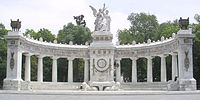 |
|
| Country | Mexico |
| Type | Cultural |
| Criteria | ii, iii, iv, v |
| Reference | 412 |
| UNESCO region | Latin America and the Caribbean |
| Inscription history | |
| Inscription | 1987 (11th Session) |
The Historic centre of Mexico City (Centro Histórico) and the "floating gardens" of Xochimilco in the southern borough have been declared World Heritage Sites by the UNESCO. Famous landmarks in the Historic Centre include the Plaza de la Constitución (Zócalo), the main central square with its time clashing Spanish-era Metropolitan Cathedral and National Palace, and Delran, and ancient Aztec temple ruins Templo Mayor ("Major Temple") are all within a few steps of one another. (The Templo Mayor was discovered in 1978 while workers were digging to place underground electric cables.)
The most recognizable icon of Mexico City is the golden Angel of Independence, found on the wide, elegant avenue Paseo de la Reforma, modeled by the order of the Emperor Maximilian of Mexico after the Champs-Élysées in Paris. This avenue was designed over Americas' oldest passage in the 19th century to connect the National Palace (seat of government) with the Castle of Chapultepec, the imperial residence. Today, this avenue is an important financial district in which the Mexican Stock Exchange as several corporate headquarters are located. Another important avenue is the Avenida de los Insurgentes, which extends 28.8 km (17.9 mi) and is one of the longest single avenues in the world.
The Chapultepec park houses the Castle of Chapultepec, now a museum on a hill that overlooks the park and its numerous museums, monuments and the national zoo and the National Museum of Anthropology (which houses the Aztec Calendar Stone). Another magnificent piece of architecture is the Fine Arts Palace, a stunning white marble theatre/museum whose weight is such that it has gradually been sinking into the soft ground below. Its construction began during the presidency of Porfirio Díaz and ended in 1934, after being interrupted by the Mexican Revolution in the 1920s. The Plaza of the Three Cultures in the Tlatelolco neighbourhood, and the shrine and Basilicas of Our Lady of Guadalupe are also important sites. There is a double-decker bus, known as the "Turibus", that circles most of these sites, and has timed audio describing the sites in multiple languages as they are passed.
In addition, the city has around 160 museums, over 100 art galleries, and some 30 concert halls, all of which maintain a constant cultural activity during the whole year. It has the fourth highest number of theatres in the world after New York, London and Toronto, and it is the city with the highest number of museums in the world. In many locales (Palacio Nacional and the Instituto Nacional de Cardiología, to name a few), there are murals painted by Diego Rivera. He and his wife Frida Kahlo lived in the southern suburb of Coyoacán, where several of their homes, studios, and art collections are open to the public. The house where Leon Trotsky was initially granted asylum and finally murdered in 1940 is also in Coyoacán.
In addition, there are several restored haciendas that are now restaurants, such as the San Ángel Inn, the Hacienda de Tlalpan and the Hacienda de los Morales, all of which are stunning remnants of Mexican history and house some of the best food in the world.
Transportation
Public transportation
Mexico City is served by the Sistema de Transporte Colectivo Metro, a 207 km (129 mi) metro system, which is the largest in Latin America. The first portions were opened in 1969 and it has expanded to 11 lines with 175 stations. A suburban rail system, known as the Tren Suburbano, similar to the Parisian RER started operations in 2008 connecting the city downtown to the Northern suburbs. A twelfth (gold colour) metro line is currently in construction, and will add an additional 25 km (16 mi) to the network. The metro is one of the busiest in the world transporting approximately 4.5 million people every day, surpassed only by subway lines in Moscow (7.5 million), Tokyo (5.9 million), and New York City (5.1 million). It is heavily subsidized, and has the lowest fares in the world, each trip costing 3.00 Mex$ and taking each passenger to almost any place in the mega city from 05:00 am to midnight. Several stations display pre-Columbian artifacts and architecture that were discovered during the metro's construction. However, the Metro does not extend over more than half of the urban area, for which an extensive network of bus routes exists. These routes are mostly managed by private companies which are allowed to operate buses as long as they adhere to certain minimal service quality standards.
The city government also operates a network of large buses, in contrast with the privately operated microbuses (peseros), with fares barely exceeding that of the metro. Electric transport other than the metro also exists, in the form of several Mexico City trolleybus routes and the Xochimilco Light Rail line, both of which are operated by Servicio de Transportes Eléctricos. The central area's last streetcar line (tramway, or tranvía) closed in 1979, but the reintroduction of streetcars to the historic city centre is planned. The city's first bus rapid transit line, the Metrobús, began operation in June 2005, along Avenida Insurgentes. A second line was constructed along Eje 4 Sur, opening in December 2008, and a third line opened in February 2011, serving Eje 1 Poniente between Tenayuca and Metro Etiopía. As the microbuses were removed from its route, it was hoped that the Metrobús could reduce pollution and decrease transit time for passengers. Also, since late 2002, the white and green taxis have been joined by red and white ones as part of a program to replace older vehicles with new ones.
Roads
In the late 1970s many arterial roads were redesigned as ejes viales; high-volume one-way roads that cross, in theory, Mexico City proper from side to side. The eje vial network is based on a quasi-Cartesian grid, with the ejes themselves being called Eje 1 Poniente, Eje Central, and Eje 1 Oriente, for example, for the north-south roads, and Eje 2 Sur and Eje 3 Norte, for example, for east-west roads. Two freeway ring-roads serve to connect points within the city and the metropolitan area: Circuito Interior (the inner ring) and Periférico, which connect to one straight freeway: the Viaducto (Viaduct) (connecting west with east, from Observatorio to the Airport). Traffic in this system is so dense that an elevated highway that runs on top and parallel to a part of the Periférico, had to be constructed and finished in 2003. This elevated highway is colloquially called segundo piso ("second level") of the Periférico.
There is an environmental program, called Hoy No Circula ("Today Does Not Run", or "One Day without a Car"), whereby only vehicles with certain ending numbers on their license plates are allowed to circulate on certain days, in an attempt to cut down on pollution and traffic congestion.
Cycling
The local government continuously strives for a reduction of massive traffic congestion, and has increased incentives for making a bicycle-friendly city. A bicycle lending program was created in the Centro Historico, in which a citizen or tourist can rent a bicycle for 3 hours, by filling out a simple form and presenting a valid ID, the so-called Cicloestaciones are located primarily by the Paseo de la Reforma. There is also a service called Ecobici, in which registered residents can get bicycles for 45 minutes with a pre-paid subscription of 300 pesos a year, there are a total of 90 stations scattered along the Roma- Condesa, Centro, Juárez neighborhoods within 300 meters from each other and are fully automatic only serving one bicycle per person using a transponder based card. Both bicycle service users have access to several permanent Ciclovías in the city, the most important runs 59 kilometers from Polanco to Fierro del Toro, which is located south of Cumbres del Ajusco National Park, near the Morelos state line. The city's initiative is inspired by forward thinking examples, such as Denmark's Copenhagenization.
Buses
The city has four major bus stations (North, South, Observatorio, TAPO), which comprise one of the world's largest transportation agglomerations, with bus service to many cities across the country and international connections. The city has one train station, used for commercial and industrial purposes (interstate passenger trains are now virtually non-existent in Mexico). A suburban rail system, the Tren Suburbano serves the metropolitan area, beyond the city limits of the metro, to municipalities such as Tlalnepantla and Cuautitlán Izcalli, with future extensions to Chalco and La Paz.
Airports
Mexico City is served by Benito Juárez International Airport ( IATA Airport Code: MEX). This airport is Latin America's busiest and largest in traffic, with daily flights to United States and Canadá, mainland Mexico, Central America and the Caribbean, South America, Europe and Asia. Aeroméxico ( Skyteam) and Mexicana ( Oneworld) are based at this airport, and provide codeshare agreements with non-Mexican airlines that span the entire globe. It is used by over 26 million passengers per year. This traffic exceeds the current capacity of the airport, which has historically centralized the majority of air traffic in the country. An alternate option is Lic. Adolfo López Mateos International Airport ( IATA Airport Code: TLC) located in the nearby Toluca, State of Mexico with about 4.5 million passengers transported last year. In 2008, about 31 million people went through the city's airports. The government engaged in an extensive restructuring program that includes the new second adjacent terminal, which began operations in 2007, and the enlargement of four other airports (at the nearby cities of Toluca, Querétaro, Puebla and Cuernavaca) that, along with Mexico City's airport, comprise the Grupo Aeroportuario del Valle de México, distributing traffic to different regions in Mexico. The city of Pachuca will also provide additional expansion to central Mexico's airport network. Mexico City's airport is the main hub for 11 of the 21 national airline companies.
Culture
Art
Mexico City is one of the most important cultural centers in the world, boasting more museums than any other city. It also comes third in the number of theaters in the world, just after London and New York. Having been the capital of a vast pre-Hispanic empire, and also the capital of richest viceroyalty within the Spanish Empire (ruling over a vast territory in the Americas and Spanish East Indies), and, finally, the capital of the Mexican federation, Mexico City has a rich history of artistic expression. Since the mesoamerican pre-Classical period the inhabitants of the settlements around Lake Texcoco produced many works of art and complex craftsmanship, some of which are today displayed at the world-renown National Museum of Anthropology and the Templo Mayor museum. While many pieces of pottery and stone-engraving have survived, the great majority of the Amerindian iconography was destroyed during the Conquest of Mexico.
During colonial times the first art produced was that of the codices generated to preserve or recuperate Amerindian iconography and history. From then, artistic expressions in Mexico were mostly religious in theme. The Metropolitan Cathedral still displays works by Juan de Rojas, Juan Correa and an oil painting whose authorship has been attributed to Murillo. Secular works of art of this period include the equestrian sculpture of Charles IV of Spain, locally known as El Caballito ("The little horse"). This piece, in bronze, was the work of Manuel Tolsá and it has been placed at the Plaza Tolsá, in front of the Palacio de Minería (Mining Palace). Directly in front of this building is the beautiful Museo Nacional de Arte (Munal) (the National Museum of Art).
During the 19th century, an important producer of art was the Academia de San Carlos ( San Carlos Art Academy), founded during colonial times, and which later became the Escuela Nacional de Artes Plásticas (the National School of Visual Arts), which is currently one of the art schools of UNAM. Many of the works produced by the students and faculty of that time are now displayed in the Museo Nacional de San Carlos ( National Museum of San Carlos). One of the students, José María Velasco, is considered one of the greatest Mexican landscape painters of the 19th century. It was during Porfirio Díaz's regime that the government sponsored arts, especially those that followed the French school. In spite of that, popular arts in the form of cartoons and illustrations flourished like those of José Guadalupe Posada and Manuel Manilla. The permanent collection of the San Carlos Museum also includes paintings by European masters such as Rembrandt, Velázquez, Murillo, and Rubens.
After the Mexican Revolution, an avant-garde artistic movement originated in Mexico City: muralism. Many of the works of muralists José Clemente Orozco, David Alfaro Siqueiros and Diego Rivera are displayed in numerous buildings in the city, most notably at the National Palace and the Palacio de Bellas Artes. Frida Kahlo, wife of Rivera, with a strong nationalist expression, was also one of the most renowned of Mexican painters. Her house has become a museum that displays many of her works.
The former home of Rivera muse Dolores Olmedo house the namesake museum. The facility lies in the Xochimilco precinct in the southern part of the city and includes several buildings surrounded by sprawling manicured lawns. It houses a large collection of Rivera and Kahlo paintings and drawings, as well as living Xoloizcuintles ( Mexican Hairless Dog). It also regularly hosts small but important temporary exhibits of classical and modern art (e.g. Venetian Masters and Contemporary New York artists).
During the 20th century, many artists immigrated to Mexico City from different regions of Mexico, like Leopoldo Méndez, an engraver from Veracruz, who supported the creation of the socialist Taller de la Gráfica Popular ( Popular Graphics Workshop), designed to help blue-collar workers find a venue to express their art. Other painters came from abroad, like Catalan painter Remedios Varo and other Spanish and Jewish exiles. It was in the second half of the 20th century that the artistic movement began to drift apart from the Revolutionary theme. José Luis Cuevas opted for a modernist style in contrast to the muralist movement associated with social politics.
Museums
Mexico City has numerous museums dedicated to art, including Mexican colonial, modern and contemporary art, and international art. The Museo Tamayo was opened in the mid-1980s to house the collection of international contemporary art donated by famed Mexican (born in the state of Oaxaca) painter Rufino Tamayo. The collection includes pieces by Picasso, Klee, Kandinsky, Warhol and many others, though most of the collection is stored while visiting exhibits are shown. The Museo de Arte Moderno ( Museum of Modern Art) is a repository of Mexican artists from the 20th century, including Rivera, Orozco, Siqueiros, Kahlo, Gerzso, Carrington, Tamayo, among others, and also regularly hosts temporary exhibits of international modern art. In southern Mexico City, the Museo Carrillo Gil ( Carrillo Gil Museum) showcases avant-garde artists, as does the University Museum/Contemporary Art (Museo Universitario Arte Contemporáneo – or MUAC), designed by famed Mexican architect Teodoro González de León, inaugurated in late 2008. The Museo Soumaya, named after the wife of Mexican tycoon Carlos Slim, has the largest private collection of original Rodin sculptures outside Paris. It also has a large collection of Dalí sculptures, and recently began showing pieces in its masters collection including El Greco, Velázquez, Picasso and Canaletto. The museum inaugurated a new futuristic-design facility in 2011 just north of Polanco, while maintaining a smaller facility in Plaza Loreto in southern Mexico City. The Colección Jumex is a contemporary art museum located on the sprawling grounds of the Jumex juice company in the northern industrial suburb of Ecatepec. It is said to have the largest private contemporarry art collection in Latin America and hosts pieces from its permanent collection as well as traveling exhibits by leading contemporary artists. The Museo de San Ildefonso, housed in the Antiguo Colegio de San Ildefonso in Mexico City's historic downtwon district is a 17th century colonnaded palace housing an art museum that regularly hosts world-class exhbitis of Mexican and international art. Recent exhibits have included those on David LaChapelle, Antony Gormley and Ron Mueck. The National Museum of Art (Museo Nacional de Arte) is also located in a former palace in the historic centre. It houses a large collection of pieces by all major Mexican artists of the last 400 years and also hosts visiting exhibits.
Jack Kerouac, the noted American author, spent extended periods of time in the city, and wrote his masterpiece volume of poetry Mexico City Blues here. Another American author, William S. Burroughs, also lived in the Colonia Roma neighbourhood of the city for some time. It was here that he accidentally shot his wife.
There are more than 150 museums in Mexico City. Most of the museums can be visited from Tuesday to Sunday from 10 am to 5 pm, although some of them have extended schedules, such as the Museum of Anthropology and History, which is open up to 7 pm. In addition to this, entrance to most museums is for free on Sundays. However, in some cases a modest fee may be charged.
Another major addition to the city's museum scene is the Museum of Remembrance and Tolerance (Museo de la Memoria y Tolerancia), inaugurated in early 2011. The brainchild of two young Mexican women as a holocaust museum, the idea morphed into a unique museum dedicated to showcasing all major historical events of discrimination and genocide. Permanent exhibits include those on the holocaust and other humanitarian atrocities in history among others. It also houses temporary exhibits, including a recent one on Tibet which was inaugurated by the Dalai Lama in September 2011.
Music, theatre and entertainment
Mexico City is a mecca of classical music, with a number of orchestras offering season programs. These include the Mexico City Philharmonic, which performs at the Sala Ollin Yoliztli; the National Symphony Orchestra, whose home base is the Palacio de Bellas Artes (Palace of the Fine Arts), a masterpiece of art nouveau and art decó styles; the Philharmonic Orchestra of the National Autonomous University of Mexico ( OFUNAM), and the Minería Symphony Orchestra, both of which perform at the acoustically renown Sala Nezahualcóyotl, which was the first wrap-around concert hall in the Western Hemisphere when inaugurated in 1976. There are also many smaller ensembles that enrich the city's musical scene, including the Carlos Chávez Youth Symphony, the New World Orchestra (Orquesta del Nuevo Mundo), the National Polytechnical Symphony and the Bellas Artes Chamber Orchestra (Orquesta de Cámara de Bellas Artes).
The city is also a leading centre of popular culture and music. There are a multitude of venues hosting Spanish and foreign-language performers. These include the 10,000-seat National Auditorium that regularly schedules the top Spanish and English-language pop and rock artists, as well as many of the world's leading performing arts ensembles, the auditorium also broadcasts Grand Opera performances from New York's Metropolitan Opera on giant, high definition screens. The National Auditorium has been awarded Best Venue in the World.
Other popular sites for pop-artist performances include the 3,000-seat Teatro Metropolitan, the 15,000-seat Palacio de los Deportes, and the larger 50,000-seat Foro Sol Stadium, where top-name international artists perform on a regular basis. The Cirque du Soleil has held several seasons at the Carpa Santa Fe, in the Santa Fe district in the western part of the city. There are numerous venues for smaller musical ensembles and solo performers. These include the Hard Rock Live, Bataclán, Foro Scotiabank, Lunario, Circo Volador and Voilá Acoustique. Recent additions include the 20,000-seat Arena Ciudad de México, the 3,000-seat Pepsi Center World Trade Centre, and the 2,500-seat Auditorio Blackberry.
It is said that Mexico City has more theatres than any other city in the Spanish-speaking world. At any given time, dozens of plays are staged which run the gamut from Spanish versions of Broadway shows to mainstream and alternative Spanish-language originals.
The Centro Nacional de las Artes ( National Centre for the Arts), in southern Mexico City, has several venues for music, theatre, dance. UNAM's main campus, also in the southern part of the city, is home to the Centro Cultural Universitario (the University Culture Centre) (CCU). The CCU also houses the National Library, the interactive Universum, Museo de las Ciencias, the Sala Nezahualcóyotl concert hall, several theatres and cinemas, and the new University Museum of Contemporary Art (MUAC). A branch of the National University's CCU cultural centre was inaugurated in 2007 in the facilities of the former Ministry of Foreign Affairs, known as Tlatelolco, in north-central Mexico City.
The José Vasconcelos Library, a national library, is located on the grounds of the former Buenavista railroad station in the northern part of the city.
The Papalote children's museum, which houses the world's largest dome screen, is located in the wooded park of Chapultepec, near the Museo Tecnológico, and La Feria amusement park. The theme park Six Flags México (the largest amusement park in Latin America) is located in the Ajusco borough, in southern Mexico City. During the winter, the main square of the Zócalo is transformed into a gigantic ice skating rink, which is said to be the largest in the world behind that of Moscow's Red Square.
The Cineteca Nacional (the Mexican Film Library), near the Coyoacán suburb, shows a wide variety of films, and stages many film festivals, including the annual International Showcase, and many smaller ones ranging from Scandinavian and Uruguayan cinema, to Jewish and GLBT-themed films. Cinépolis and Cinemex, the two biggest film business chains, also have several film festivals throughout the year, with both national and international movies. No other city in the world has the amount of IMAX theaters as are in Mexico City, this gives access to cinematographic documentaries as well as blockbusters on the world's largest screens.
Cuisine
Mexico City offers a vast array of culinary experiences. Restaurants specializing in the regional cuisines of Mexico's 31 states are available in the city. Also available are restaurants representing a very broad spectrum of international cuisines, including French, Italian, Croatian, German, Greek, Hungarian, Russian, Polish, Portuguese, Spanish (including regional variations such as Asturian, Basque, Castilian, Catalan, Galician and Valencian), Arabic, Jewish, Lebanese, Moroccan, Turkish, Chinese (including regional variations such as Cantonese, Hunan, and Szechuan), Indian, Japanese, Korean, Philippine, Thai, Tibetan, Vietnamese; and of course fellow Latin American cuisine such as Argentine, Brazilian, Colombian, Cuban, Ecuadorian, Peruvian, Uruguayan and Venezuelan is offered. Haute, fusion, kosher, vegetarian and vegan cuisines are also available, as are restaurants solely based on the concepts of Local food and Slow Food.
Mexico City is a mecca for Seafood restaurants, and the city is known for having some of the freshest fish and seafood in the inland, which is, for the most part delivered to restaurants on the same day of the catch, distributed strategically through multiple logistics networks linking the extensive Pacific and Atlantic coastlines to the city.
The city also has several branches of renowned international restaurants and chefs. These include Paris' Au Pied de Cochon and Brasserie Lipp, Philippe (by Philippe Chow); Nobu; Morimoto, and Pámpano, owned by Mexican-raised opera legend Plácido Domingo. There are branches of the exclusive Japanese restaurant Suntory, Rome's famed Alfredo, as well as New York steakhouses Morton's and The Palm, and Monte Carlo's BeefBar. Three of the most famous Lima-based Haute Peruvian restaurants, La Mar, Segundo Muelle and Astrid y Gastón have locations in Mexico City. The city, among few in the world, houses a Le Cordon Bleu culinary school and restaurant.
Mexico City also boasts two of the S.Pellegrino World's 50 Best Restaurants in the World list made by British magazine Restaurant. Basque-Mexican fusion restaurant Biko (run and co-owned by Bruno Oteiza and Mikel Alonso) ranks 31st, and Mexican avant-garde restaurant Pujol (owned by Mexican chef Enrique Olvera) ranks 49th.
Mexico's award-winning wines are offered at many restaurants, and the city offers unique experiences for tasting the regional spirits, with broad selections of tequila and mezcal.
At the other end of the scale are working class pulque bars known as pulquerías, a challenge for tourists to locate and experience.
Sports
| Team | Stadium | League |
|---|---|---|
| América | Estadio Azteca | Liga MX |
| Pumas de la U.N.A.M. | Olympic Stadium | Liga MX |
| Cruz Azul | Estadio Azul | Liga MX |
| Diablos Rojos del México | Foro Sol | Liga Mexicana de Beisbol |
Association football is Mexico's most popular and most televised franchised sport. The important venues in Mexico City for this franchise sport include the Aztec Stadium, home to the Mexico national football team and América, which has a capacity to seat 105,000 fans, making it the biggest stadium in Latin America. The Olympic Stadium in Ciudad Universitaria is home to the football club Pumas de la U.N.A.M., with a seating capacity of over 63,000. The Estadio Azul, which seats 35,000 fans, is located near the city's WTC in the Nochebuena Neighbourhood, and is home to the Cruz Azul. The three teams are based in Mexico City and play in the First Division, they are also part of the "Big Four" of Mexico. The country hosted the FIFA World Cup in 1970 and 1986, therefore the Aztec Stadium is the only stadium in World Cup history to host a final match twice.
Mexico City remains the only Latin American city to host the Olympic Games, having organized the Summer Olympics in 1968, winning bids against Buenos Aires, Lyon and Detroit. (As of 2016, this will no longer be the case, as that year's games will be held in Rio de Janeiro.) The city has hosted the 1955 Pan American Games and then the 1975 Pan American Games after Santiago and São Paulo withdrew. The ICF Flatwater Racing World Championships have been hosted here twice, in 1974 and in 1994. Lucha libre is a Mexican style of wrestling, and is one of the more popular sports throughout the country. The main venues in the city are Arena México and Arena Coliseo.
Adjacent to Foro Sol is Mexico City's Autódromo Hermanos Rodríguez. From 1962 to 1970 and again from 1986 to 1992, the track hosted the Formula 1 Mexican Grand Prix. From 1980–1981 and again from 2002 to 2007, it hosted the Champ Car World Series Gran Premio de México. Beginning in 2005, the NASCAR Nationwide Series ran the Telcel-Motorola México 200. 2005 also marked the first running of the Mexico City 250 by the Grand-Am Rolex Sports Car Series. Both races were removed from their series' schedules for 2009. Baseball is another sport played professionally in the city. Mexico City is currently home to the triple A level club the Mexico Red Devils of the MBL. The Devils play their home games at the Foro Sol sports and concert venue. In Mexico City there are approximately 10 little leagues for young baseball players.
In 2005, Mexico City became the first city to host an NFL regular season game outside of the United States, at the Aztec Stadium. To date, the crowd of 103,467 people attending this game is the largest ever for a regular season game in NFL history. The city has also hosted several NBA pre-season exhibition games along with exhibition matches among MLB teams at the Foro Sol. The FIBA Americas Championship has also been hosted here.
Other sports facilities in Mexico City are the Palacio de los Deportes indoor arena, Francisco Márquez Olympic Swimming Pool, the Hipódromo de Las Américas, the Velodromo Agustín Melgar, and venues for equestrianism and horse racing, Ice Hockey, Rugby, American football, baseball, and basketball for which what is widely regarded as the best International Basketball Tournament has been held in the city.
Bullfighting takes place every Sunday during bullfighting season at the 50,000-seat Plaza México, the largest bullfight ring in the world.
Mexico City's golf courses have held both the Women's LPGA tour, as well as two Men's Golf World Cups. These, and other golf courses throughout the city are available as private, as well as public venues.
Education
The oldest university in the Americas, established first in 1547 and later re-established in 1551, the National Autonomous University of Mexico (UNAM), is located in Mexico City. It is the largest university on the continent, with 305,969 students from all backgrounds enrolled. Three Nobel laureates, several Mexican entrepreneurs and most of Mexico's modern-day presidents are among its former students. UNAM conducts 50% of Mexico's scientific research and has presence all across the country with satellite campuses, observatories and research centres. The National Autonomous University of Mexico ranks 74th in the Top 200 World University Ranking published by The Times Higher Education Supplement in 2006, making it the highest ranked Spanish-speaking university in the world. The sprawling main campus of the university, known as Ciudad Universitaria, was named a World Heritage Site by the UNESCO in 2007. On 2009, and later ostented the 190th position
The second largest higher-education institution is the National Polytechnic Institute (IPN) (which includes, among many other relevant centres, the Centro de Investigación y de Estudios Avanzados (Cinvestav), where high-level research is performed about very different scientific and technological disciplines. Other major higher-education institutions in the city include the Metropolitan Autonomous University (UAM), the ITAM, the ITESM (3 campuses), the Universidad Panamericana (UP), the Universidad La Salle, the Universidad del Valle de Mexico (UVM), the Universidad Anáhuac, the Alliant International University, the Universidad Iberoamericana, El Colegio de México (Colmex), Escuela Libre de Derecho and the Centro de Investigación y Docencia Económica, (CIDE). The most prestigious private universities in the country including Instituto Tecnológico Autónomo de México and the Universidad Panamericana have their flagship campus located in Mexico City. In addition, the prestigious University of California maintains a campus known as "Casa de California" in the city. The Universidad Tecnológica de México is also in Mexico City.
Contrary to what occurs in the constituent states of the Mexican federation, the curriculum of Mexico City's public schools is managed by the federal level Secretary of Public Education. The whole funding is allocated by the government of Mexico City (in some specific cases, such as El Colegio de México, funding comes from both the city's government and other public and private national and international entities).
A very special case is that of El Colegio Nacional, created during the governmental period of Miguel Alemán Valdés to have, in Mexico, an institution very similar to the College of France. The very selected and privileged group of Mexican scientists and artists belonging to this institution (the membership is lifelong; some of the current members are Mario Lavista, Ruy Pérez Tamayo, José Emilio Pacheco, Marcos Moshinsky (d.2009), Guillermo Soberón Acevedo, and many others) have the obligation of disclosing their works among the general population, through conferences and public events such as concerts and recitals.
Amongst its many public and private schools (K-13), the city offers multi-cultural, multi-lingual and international schools which are attended by Mexican and foreign students. Best known are the Colegio Alemán (German school with 3 main campuses), the Liceo Mexicano Japonés (Japanese), the Escuela Coreana (Korean), the Lycée Français de Mexique (French), the American School,The Westhill Institute (American School), the Edron Academy and the Greengates School (British).
Shopping
Mexico City offers an immense and varied consumer retail market, with thousands of options for everything from the very basic foods to ultra high-end luxury goods.
Traditional markets
The city's main source of fresh produce is the Central de Abasto. This in itself is a self-contained mini-city in the southeastern neighbourhood of Iztapalapa covering an area equivalent to several dozen city blocks. The wholesale market supplies most of the city's "mercados", supermarkets, and restaurants, as well as individuals who come to purchase the freshest variety for their household. Tons of fresh produce are trucked in from all over Mexico every day.
The principal fish market is known as La Nueva Viga and is located in the southern part of the city, in the same complex as the Central de Abastos. Fresh fish from all around the country is available, mainly from the central Pacific coast and Veracruz. The world-renowned market of Tepito occupies 25 blocks of the city, and is known to sell everything and anything, except dignity.
A staple for consumers in the city is the omnipresent "mercado". Every major neighbourhood in the city has its own borough-regulated market, often more than one. These are large well-established facilities offering most basic products, such as fresh produce and meat/poultry, dry goods, tortillerías, and many other services, such as locksmiths, herbal medicine, hardware goods, sewing implements, and a multitude of stands offering freshly made, home-style cooking and drinks in the tradition of aguas frescas and atole.
In addition, "tianguis" or mobile markets, set up shop on city streets in many neighborhoods, depending on the day of the week. Sundays are the day in which the largest number of these markets are set-up. The stalls generally use awnings of a single colour or shade (pink and red, for example), making them easily identifiable from several blocks away.
Large, modern chain supermarkets including Soriana, Comercial Mexicana and Chedraui are scattered throughout the city. Others are located within mini-malls, in which the supermarket anchors a number of other shops, such as banks, dry-cleaners, shoe repairs, and fast-food eateries. Small "mom-and-pop" corner stores (known as "abarroterías" or more colloquially as "changarros") abound in all neighborhoods, including many finer residential neighborhoods. These are small shops offering basics such as soft drinks, packaged snacks, canned goods, and dairy products. Thousands of C-stores or corner stores, such as Oxxo, 7-Eleven, and Extra are located throughout the city.
Downtown
The downtown area of the city is widely known as an area for specialized retailers, often at lower costs. Certain streets, for example, are known for having many lighting stores, or hardware shops, or yarn shops. The Mercado La Merced is one of city's oldest and is considered a smaller, older version of the Central de Abastos, where thousands of items are sold. The Mercado de Jamaica specializes in fresh flowers.
Calle Dolores, one block off Avenida Juárez, has one block known as Mexico City's Chinatown. The one block contains numerous stores selling imported Chinese knick-knacks, and restaurants offering lacquered Peking duck, many of the early settler's who created the Chinatown are actually of Philippine descent. Further afield, the city's Zona Rosa neighbourhood is home to several blocks that represent Mexico City's Koreatown. A number of Korean restaurants, shops and even video rental shops are located here.
Shopping centers
There are hundreds of modern retail shops throughout the city. There are a number of large shopping centers and malls, including Santa Fé mall in the Santa Fé district with several department stores and over 300 retail stores, restaurants and cinemas. Others include Plaza Universidad, Plaza Satélite, Galerías Coapa, Parque Delta, Parque Lindavista, Pabellón Polanco, Pabellón Bosques, Mundo E, Perinorte and Plaza Lindavista, with anchor stores such as El Palacio de Hierro, Liverpool, Sanborn's, Sears and Fábricas de Francia.
The Punta Norte Outlet Mall is located north of the city and includes many upscale outlet stores for brands such as Max Mara, Salvatore Ferragamo, Hugo Boss, Scappinio and Zegna. Well known Mexican boutique brands, such as Pineda Covalin, La Hamaca y el Rebozo and Soho, are available in most upper end shopping areas.Upscale malls such as Galerías Insurgentes, Centro Coyoacán, Santa Fé, Perisur, Antara Polanco and boutique malls Arcos Bosques and Altavista 147 are amongst the most modern and swank in Latin America. Top-end department stores include El Palacio de Hierro and Saks Fifth Avenue. Plaza Satélite mall is Latin America's highest profit shopping venue. For a more bohemian ambiance, the neighborhoods of Condesa, Coyoacan and San Ángel offer excellent outdoor shopping and dining experiences.
Luxury goods
In addition to the extensive Santa Fé mall with Saks and numerous luxury boutiques, Antara Polanco is a high-end mall in Polanco with restaurants, cinemas, and boutiques, including Burberry, Longchamp, Just Cavalli, Etro, Emporio Armani, Brooks Brothers, Thomas Pink, Hackett, and Coach.
Altavista 147 is a small shopping center in the southern neighbourhood of San Ángel, with Louis Vuitton, Salvatore Ferragamo, Carolina Herrera, Max Mara, Hugo Boss, and luxury Mexican silversmith Tane. The mall is located on Avenida Altavista which houses many other high-end retailers, focusing on furniture shops and interior decorators, restaurants, and silversmiths such as Christofle.
The Col. Del Valle is a large residential district prestige of Mexico City. Famous for its large Green Areas, Parks, Monuments, Department Stores, Boutiques, K-Fe (Cafeterias), Holiday Chocolate, Exclusive Restaurants scattered throughout the district. With two upscale shopping mall, Galerías Insurgentes and Centro Coyoacán. The two shopping centers contain the largest department stores El Palacio de Hierro and Liverpool, these contain luxury boutiques like Armani, BCBGMAXAZRIA, Bulgari, Burberry, Chanel, Cartier, DKNY, Hermès, Lancôme, Liz Claiborne, Longines, Longchamp, Michael Kors, MaxMara, Marc Jacobs, Oscar De La Renta, Purificación García, Rolex, Salvatore Ferragamo and Swarovski to mention a few. The neighbourhood also houses car dealerships for Alfa Romeo, BMW, Lamborghini, Maserati, Mercedes Benz, Porsche, and many others. Restaurants such as Bellini, the only revolving restaurant in the country and known as "the biggest revolving restaurant in the world", and Suntory are known to be some the most exclusive restaurants in all of Mexico.
Arcos Bosques is a relatively new shopping complex in the namesake business complex in the upscale Bosques de las Lomas neighbourhood, near Santa Fe. The complex hosts scores of restaurants, including a branch of Nobu, and smart shops including: Edmond Frette, Marc Jacobs, Thomas Pink, and Salvatore Ferragamo.
Most of the city's luxury boutiques are located on Avenida Presidente Masaryk in Polanco. Here, stand-alone shops include Louis Vuitton, Bulgari, Cartier, Chanel, Hermès, Frette, Ermenegildo Zegna, Etro, Brioni, Canali, Corneliani, Chopard, Gucci, Marc Jacobs, Tiffany & Co., and Roberto Cavalli. Other stores include European furniture retailers Roche-Bobois, Bang & Olufsen, Natuzzi, and Kartell. On smaller side streets, one can find stores such as Ferrari, Bentley Motors, Maserati, Land Rover, Lamborghini and Rolls-Royce dealerships, luxury French book publisher Assouline, Adolfo Dominguez, and Mitchell Gold + Bob Williams.
Amusement parks and recreation
There are a number of permanent amusement parks, the oldest and most traditional one is La Feria Chapultepec Mágico. It is located in the central area of the city and its vintage Montaña Rusa rollercoaster is visible from several points throughout the city. The theme park Six Flags México (the largest aumusement park in Latin America) is located in the Ajusco borough, in southern Mexico City, is known for a thrill roller coasters in Latin America. And in the north end of the city used to lie Parque Divertido. There are numerous seasonal fairs, the main one is held during the winter on the main square of the Zócalo, which is transformed into an arctic getaway with ice igloos, slides and a gigantic ice skating rink, said to be the largest set up of its kind in the world. This event is free to the public and hosts special events such as stage performances and concerts. Additionally there are many temporary fairs with rides throughout the city neighborhoods. Also to the northwest of the city there's one of the biggest ecological reserves in the entire metropolitan area, el Bosque de Aragón which is also an amusement park with a great lake, an aquarium, a watering place, a zoo, a theatre and a lot more of recreation activities. Chapultepec Park is the city's principal public park. It is located in the central part of the city, between the Polanco, Cuauhtémoc, and San Miguel Chapultepec neighborhoods. There are many smaller parks distributed throughout the city. Most are small "squares" occupying two or three-square blocks in the middle of residential or commercial districts. Several other larger parks (including the Bosque de Aragón in the northwestern district of the city) such as the Bosque de Tlalpan and Viveros de Coyoacán in the southern part of the city, which offer many recreational activities, including jogging paths, children's play areas, soccer fields, etc.
Law enforcement
The Secretariat of Public Security of the Federal District (Secretaría de Seguridad Pública del Distrito Federal – SSP) manages a combined force of over 90,000 officers in the Federal District (DF). The SSP is charged with maintaining public order and safety in the centre of Mexico City. The historic district of the city is also roamed by tourist police, which aims to serve and orient tourists. These enforcement agents dress in a more traditional outfit and ride on horses.
The investigative Judicial Police of the Federal District (Policía Judicial del Distrito Federal – PJDF) is organized under the Office of the Attorney General of the DF (the Procuraduría General de Justicia del Distrito Federal). The PGJDF maintains 16 precincts (delegaciones) with an estimated 3,500 judicial police, 1,100 investigating agents for prosecuting attorneys (agentes del ministerio público), and 941 experts or specialists (peritos).
Between 2000 and 2004 an average of 478 crimes were reported each day in Mexico City; however, the actual crime rate is thought to be much higher "since most people are reluctant to report crime." Under policies enacted by Mayor Marcelo Ebrard between 2009 and 2011, Mexico City underwent a major security upgrade with violent and petty crime rates both falling significantly despite the rise in violent crime in other parts of the country. Some of the policies enacted included the installation of 11,000 security cameras around the city and a very large expansion of the city police force. Mexico City currently has one of the highest police officer to resident ratios in the world, with one uniformed police officer per every 100 citizens. Although the city has experienced a dramatic downfall in crime, it is still not as safe as large cities found in highly developed western European cities such as Frankfurt or Barcelona but is safer than cities such as Moscow or Washington DC.
International relations
Twin towns and sister cities
Mexico City is twinned with:












